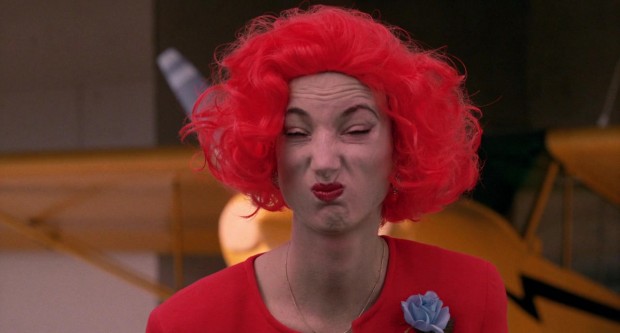You have no items in your cart. Want to get some nice things?
Go shopping“I want all my Garmonbozia.”
![Don't pretend to understand the film's symbolism the first time around. [Property of Lynch-Frost Productions]](https://www.litromagazine.com/wp-content/uploads/2014/10/I_am_the_arm-620x334.jpg)
Twin Peaks: Fire Walk With Me was booed at Cannes. Many viewers, including a young Quentin Tarantino, walked out of the première screening before the credits rolled. In the U.S.A., audiences went one step further and didn’t even bother to turn up; probably because the American critics were even more venomous than their European counterparts. Those few fans who did see it were even more perplexed by what they thought would be a Twin Peaks movie, but was in fact the least accessible David Lynch film yet. A few lonely voices, especially in Britain, were kinder and at least pretended to know what it was all about. Suffice to say, Lynch’s cinematic prequel to his hit TV show was divisive when it was unleashed on the world in 1992.
To understand the reaction, you need only look at the name. Such a surreal subtitle will send die-hard Peaks fans squealing with excitement, set casual fans straining to recall its significance and strike the uninitiated as pretentious. They’d all be right in their own ways, because Fire Walk With Me is incomprehensible unless you’ve seen every episode of the TV show, and a deliberately abstract exercise in symbolism. Above all this, however, it is something that no-one was prepared to accept: it is a horror movie.
Twin Peaks, as you probably know, is a two-season television phenomenon set in a sleepy Washington town that was cancelled before it could fully resolve its myriad of mysteries. Centred around the murder of homecoming queen Laura Palmer, the show soon revealed that something supernatural was going on, and its unique mythology was barely halfway explained when the story was prematurely ended on a cruel cliffhanger in 1991. So, when David Lynch announced he’d be releasing a spin-off movie within a year of the show’s end, fans were ecstatic. All their questions would be answered!
Unfortunately for them, Lynch had planned a prequel that would show the events leading to Laura Palmer’s murder. Actress Sheryl Lee’s haunting beauty loomed large over the TV show’s narrative, so it was only fitting that the film should choose her as its subject matter and allow Lee the chance to imbue Laura with life, as well as death. But making a prequel always requires a foregone conclusion, and in this case a rather grim one. Consequently Lynch chose to embrace the sense of destiny inherent to any prequel, and transform it into a tragic and unnerving atmosphere of doom. This makes for uncomfortable viewing.

Discomfort isn’t a problem in horror – in fact, we welcome it whenever we want to be scared by a film. However, Fire Walk With Me suffers from the problem of its tone; that is, it’s too perfectly judged to satisfy anybody. Anyone who hasn’t seen the TV show will be bewildered by the brief cameos and bizarre beings who inhabit the otherworldly plain in Twin Peaks, and will struggle to justify the film’s self-serious and relentlessly bleak approach. There’s a backwards-talking dwarf and a David Bowie appearance? Chris Isaak plays an FBI agent? David Lynch plays his boss? It all seems rather pretentious (there’s that word again). On the other hand, the show is famed for its surprising sense of humour, its mystery, and its sexiness. Fire Walk With Me is dark and foreboding, lacking any mystery because it shows events that have already happened, and consciously unsexy in its depiction of a high school girl lost in a world of drugs, prostitution, rape and incest. No wonder fans were disappointed. Or maybe it’s just because none of their favourite characters were in the film.
Given its subject matter, it’s unsurprising that Lynch opted to emphasise the horror of the story as Laura Palmer’s life spirals ever further down the drain until she must die. In a way, Lynch is punishing viewers for their curiosity. “You want to know who killed Laura Palmer?” he asks. “You want to know how she died? Brace yourself.” The result is a dream-like narrative, lacking exposition or traditional scene transitions and resting squarely on the shoulders of Sheryl Lee, who gives a tremendous performance that makes us experience every ounce of pain and confusion Laura feels. She screams and panics and cries her way through the film, laughing only when lost in the false glee of cocaine. Lynch shows this all in woozy close-ups, uncomfortably long takes broken only by cross-fades of juxtaposed imagery, and a range of droning sound effects that scorch the ear. The effect is an emotionally draining two-hour nightmare, filled with the unexplained and the sorrow of a victim with no escape from a dark world that consumes her. When the final murder occurs, it’s a truly unpleasant scene, made all the more shocking by the violence taking place off-screen – like Hitchcock’s Psycho, we are left to imagine the physical damage, because nothing could be worse than what we each see in our own nightmares.
That is not to say the film is without flaws. It is peculiarly structured, beginning with a half-hour short film following the investigation into another murder before cutting rather suddenly to Laura Palmer’s story. Characters come and go, some for just a single shot, usually without introduction and always without explanation. Lynch takes our familiarity with the show’s minutiae for granted, which is fine but drastically reduces the film’s accessibility, even to fans. Some sequences flow elegantly, other scenes are disjointed and oddly assembled. This certainly adds to the surreal sense of discomfort, but doesn’t help the film look especially professional, which is disappointing from Lynch. Yet none of this takes away from the excellent performances, the gripping atmosphere and the ethereal score by Angelo Badalamenti.
![Sheryl Lee is fantastic as the living, suffering Laura. [Lynch-Frost Productions]](https://www.litromagazine.com/wp-content/uploads/2014/10/laura-620x364.jpg)
Perhaps Fire Walk With Me would have been better served by being longer. It already clocks in at just over two hours, but in 2014 an additional 90 minutes of deleted scenes were released, edited and scored under Lynch’s supervision in such a way as to make another mini-movie, albeit one with no discernible plot. A lot of these new scenes are vignettes with familiar faces from the TV show: they don’t have a clear place in the film’s narrative, but they bring a lot of warmth, context and humour. Other scenes are transitional moments, inessential but useful to making the film flow more smoothly, while many scenes expand upon the film’s supporting characters, particularly the FBI agents. Lynch says he likes and is proud of the final product, so clearly at some point in the editing process he decided to reduce the presence of peripheral characters and focus firmly on Laura – and in doing so realised there was no place for comedy. Given the tragedy of Laura he was right, of course, but the film’s harshness makes it a depressing and bitter pill to swallow.
It seems that today critical opinion on Fire Walk With Me is polarised; people either love it or hate it. As yet, there is no in-between ground. I choose to stand firmly in that No Man’s Land, neither loving nor hating it, instead electing to accept it for what it is. I’ve only seen it once, and found it so disturbing I can’t say I’ll see it again in a rush. But I will watch it again, without doubt; and for me that is a clearer indication of its quality than any booing critic.

About Robin McConnell
Robin is an obsessive film fanatic and occasional person. When he is not watching films or editing Litro Film & Media he can be found writing and producing the Alltime channels on Youtube. He is often distracted by the need to write scripts and short stories.





Good review. I’ve actually found out from people who came to FWWM cold that the film does work without having seen the series (at least for some viewers) – many of the things that seem to fans like references or cameos just play as background noise to someone. They tend to disregard the mythology and see it as all being Laura’s projection (although . As you note, the horror connection helps. Apparently fans of horror, Lynch and/or the avant garde are more open to the movie than (sadly) a lot of series fans because they bring less expectations to it.
I do love the movie, but I also had to wait about 5 years before watching it again; it left such a strong and troubled impression that first viewing. Among its many disorienting accomplishments, there’s the amazement that somehow this grew out of the series. Another reminder that Lynch is one of our most radical, adventurous filmmakers. Who else would create a hit mystery TV show that’s fun and comedic as well as spooky, and then adopt the dar, harrowing victim’s point of view as the premise of the film? Still gives me a pleasing sense of cognitive dissonance.